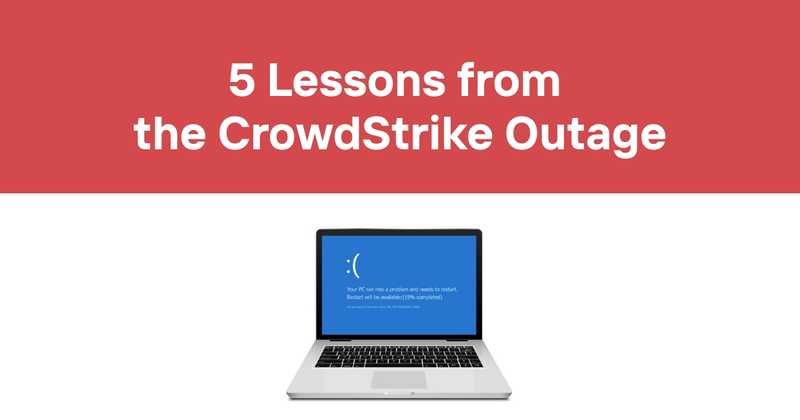5 Critical Lessons from the CrowdStrike Outage for Improving Crisis Management
On July 19, 2024, CrowdStrike, a leading cybersecurity firm, experienced a severe outage that disrupted operations for thousands of businesses worldwide. This incident serves as a stark reminder of the critical importance of robust crisis management strategies in today's interconnected digital landscape.
The CrowdStrike outage not only exposed technical vulnerabilities but also highlighted significant gaps in communication and customer experience management during times of crisis. By examining this event closely, we can extract valuable lessons that will help organizations better prepare for and respond to similar incidents in the future.
This article will explore five key takeaways from the CrowdStrike outage, offering insights and actionable strategies to enhance your organization's crisis management capabilities. Whether you're a software developer, IT professional, or business leader, these lessons will prove invaluable in strengthening your ability to navigate unforeseen challenges and maintain customer trust.
Table of Contents
- The Anatomy of the CrowdStrike Outage
- Lesson 1: Prioritize Transparent and Timely Communication
- Lesson 2: Develop a Comprehensive Incident Response Plan
- Lesson 3: Invest in Robust Technical Infrastructure and Redundancies
- Lesson 4: Foster a Culture of Continuous Improvement and Learning
- Lesson 5: Prioritize Customer Experience During Crisis Situations
- Implementing These Lessons in Your Organization
- Conclusion
The Anatomy of the CrowdStrike Outage
Before delving into the lessons learned, it's crucial to understand the timeline and impact of the CrowdStrike outage:
- July 19, 2024: CrowdStrike experiences a significant outage affecting its global security services.
- Thousands of businesses lose access to critical security monitoring and incident response capabilities.
- The outage lasts several hours, causing widespread disruption and financial losses.
- Initial communication from CrowdStrike is limited, leaving customers in the dark about the extent of the problem.
- In the aftermath, CrowdStrike faces criticism for its handling of the situation and subsequent attempts at making amends.
This event underscores the far-reaching consequences of service disruptions in the cybersecurity industry and the importance of effective crisis management.
Lesson 1: Prioritize Transparent and Timely Communication
One of the most glaring issues during the CrowdStrike outage was the lack of clear, timely communication. This left customers frustrated and uncertain about the status of their security systems.
Key Takeaways:
-
Establish multiple communication channels: Develop a multi-channel approach to reach customers through email, social media, status pages, and direct phone lines.
-
Provide regular updates: Even if you don't have all the answers, frequent updates demonstrate that you're actively working on the problem.
-
Be transparent about the issue: Clearly explain what happened, its impact, and the steps being taken to resolve it.
-
Empower your support team: Ensure your customer support representatives have the latest information and authority to assist customers effectively.
Implementation Strategies:
- Create pre-approved message templates for various crisis scenarios to expedite communication.
- Implement a dedicated status page that provides real-time updates on service health.
- Establish an internal communication protocol to ensure all team members are aligned on messaging.
Lesson 2: Develop a Comprehensive Incident Response Plan
The CrowdStrike outage highlighted the importance of having a well-defined incident response plan in place. Such a plan ensures that your team can act swiftly and effectively when crises occur.
Key Components of an Incident Response Plan:
-
Clearly defined roles and responsibilities: Assign specific tasks to team members to avoid confusion during a crisis.
-
Escalation procedures: Establish clear guidelines for when and how to escalate issues to senior management or external partners.
-
Communication protocols: Define who speaks to customers, the media, and other stakeholders during an incident.
-
Technical response procedures: Outline step-by-step processes for identifying, containing, and resolving different types of incidents.
-
Recovery and post-incident analysis: Include procedures for service restoration and conducting a thorough post-mortem analysis.
Implementation Strategies:
- Conduct regular tabletop exercises to test and refine your incident response plan.
- Create detailed playbooks for different types of incidents (e.g., security breaches, service outages, data loss).
- Integrate your incident response plan with your business continuity and disaster recovery strategies.
Lesson 3: Invest in Robust Technical Infrastructure and Redundancies
The CrowdStrike outage demonstrated the critical need for resilient technical infrastructure and effective redundancy measures. As a software developer or IT professional, ensuring your systems can withstand failures is paramount.
Key Considerations:
-
Distributed architecture: Design your systems with redundancy and fault tolerance in mind, using distributed architectures to minimize single points of failure.
-
Load balancing: Implement effective load balancing strategies to distribute traffic and prevent overload on any single component.
-
Automated failover: Develop automated failover mechanisms to quickly redirect traffic or workloads in case of system failures.
-
Regular testing: Conduct frequent stress tests and simulated failure scenarios to identify weaknesses in your infrastructure.
-
Monitoring and alerting: Implement comprehensive monitoring solutions to detect issues early and trigger appropriate responses.
Implementation Strategies:
- Conduct a thorough analysis of your current infrastructure to identify potential vulnerabilities and single points of failure.
- Implement a multi-region or multi-cloud strategy to enhance resilience against localized outages.
- Develop and maintain up-to-date documentation of your system architecture and dependencies.
Lesson 4: Foster a Culture of Continuous Improvement and Learning
The aftermath of the CrowdStrike outage provides an opportunity to reflect on the importance of continuous improvement in crisis management strategies.
Key Aspects:
-
Post-incident analysis: Conduct thorough post-mortems after every incident, no matter how small, to identify areas for improvement.
-
Knowledge sharing: Encourage open communication and knowledge sharing across teams to learn from past experiences.
-
Regular training: Provide ongoing training for all staff members on crisis management procedures and best practices.
-
Feedback loops: Establish mechanisms to collect and act on feedback from customers, employees, and partners following incidents.
-
Industry collaboration: Participate in industry forums and share experiences to contribute to collective learning and improvement.
Implementation Strategies:
- Implement a blameless post-mortem process to encourage honest and open discussions about incidents.
- Create a centralized knowledge base to document lessons learned and best practices.
- Establish key performance indicators (KPIs) for your incident response process and regularly review and improve them.
Lesson 5: Prioritize Customer Experience During Crisis Situations
The CrowdStrike outage highlighted the critical importance of maintaining a customer-centric approach, even in the midst of a crisis. How you treat your customers during challenging times can have a lasting impact on their trust and loyalty.
Key Considerations:
-
Empathy and understanding: Acknowledge the impact of the incident on your customers and express genuine concern for their situation.
-
Proactive support: Reach out to affected customers proactively, rather than waiting for them to contact you.
-
Clear expectations: Set realistic expectations about resolution timelines and keep customers updated on progress.
-
Compensation and goodwill gestures: Consider appropriate compensation or goodwill gestures to affected customers, ensuring they are commensurate with the impact of the incident.
-
Learning from customer feedback: Actively seek and incorporate customer feedback into your post-incident improvement process.
Implementation Strategies:
- Develop customer communication templates that strike the right balance between professionalism and empathy.
- Implement a customer impact assessment process to quickly identify and prioritize support for the most affected customers.
- Create a dedicated crisis support team trained in handling high-stress customer interactions.
Implementing These Lessons in Your Organization
To effectively implement these lessons from the CrowdStrike outage, consider the following steps:
-
Conduct a thorough assessment: Evaluate your current crisis management capabilities against the lessons outlined in this article.
-
Prioritize improvements: Based on your assessment, identify the most critical areas for improvement and create an action plan.
-
Allocate resources: Ensure you have the necessary resources (personnel, technology, budget) to implement improvements.
-
Involve stakeholders: Engage key stakeholders from across your organization in the improvement process to ensure buy-in and comprehensive coverage.
-
Regular review and updates: Establish a cadence for reviewing and updating your crisis management strategies to ensure they remain effective and relevant.
Sample Action Plan:
| Priority | Action Item | Responsible Team | Timeline | Success Metrics |
|---|---|---|---|---|
| High | Develop multi-channel communication strategy | Marketing & PR | Q3 2024 | Reduction in customer complaints about communication during incidents |
| Medium | Implement automated failover for critical systems | IT Operations | Q4 2024 | 99.99% uptime for core services |
| Low | Establish industry partnerships for knowledge sharing | Leadership Team | Q1 2025 | Participation in at least two industry forums annually |
Conclusion
The CrowdStrike outage serves as a powerful reminder of the importance of effective crisis management in today's digital landscape. By learning from this incident and implementing the lessons outlined in this article, organizations can significantly enhance their ability to navigate and mitigate the impact of unforeseen disruptions.
Key takeaways include:
- Prioritizing transparent and timely communication
- Developing a comprehensive incident response plan
- Investing in robust technical infrastructure and redundancies
- Fostering a culture of continuous improvement and learning
- Prioritizing customer experience during crisis situations
By focusing on these areas, software developers, IT professionals, and business leaders can build more resilient organizations that are better equipped to handle crises while maintaining customer trust and loyalty.
Remember, effective crisis management is not a one-time effort but an ongoing process of preparation, execution, and learning. By continuously refining your strategies and staying adaptable, you can turn potential crises into opportunities for growth and improvement.



